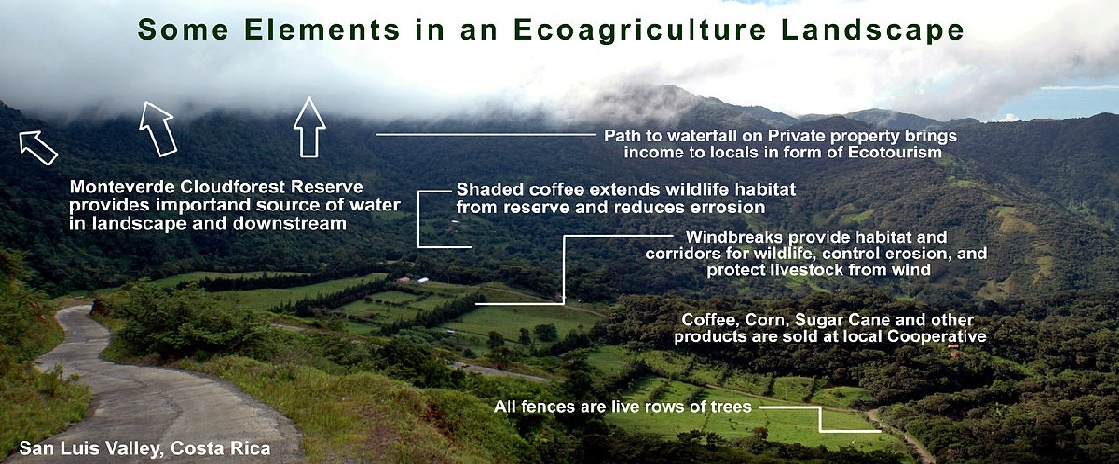Eco friendly agriculture describes landscapes that support both agricultural production and biodiversity conservation, working in harmony together to improve the livelihoods of rural communities. While many rural communities have independently practiced eco-agriculture for thousands of years, over the past century many of these landscapes have given way to segregated land use patterns, with some areas employing intensive farming practices without regard to biodiversity impacts, and other areas fenced off completely for habitat or watershed protection. A new eco-agriculture movement is now gaining momentum to unite land managers and other stakeholders from diverse environments to find compatible ways to conserve biodiversity while also enhancing agricultural production.
Eco-agriculture is both a conservation strategy and a rural development strategy. Eco-agriculture recognizes agricultural producers and communities as key stewards of ecosystems and biodiversity and enables them to play those roles effectively. Eco-agriculture applies an integrated ecosystem approach to agricultural landscapes to address all three pillars—conserving biodiversity, enhancing agricultural production, and improving livelihoods—drawing on diverse elements of production and conservation management systems. Meeting the goals of eco-agriculture usually requires collaboration or coordination between diverse stakeholders who are collectively responsible for managing key components of a landscape.
Eco-agriculture uses the landscape as a unit of management. A landscape is a cluster of local ecosystems with a particular configuration of topography, vegetation, land use, and settlement. The goals of eco-agriculture—to maintain biodiversity and ecosystem services, manage agricultural production sustainably, and contribute to improved livelihoods among rural people—cannot be achieved at just a farm or plot level, but are linked at the landscape level. Therefore, to make an impact, all of the elements of a landscape as a whole must be considered; integrated landscape management is an approach that seeks to achieve this.
Defining a landscape depends on the local context. Landscapes may be defined or delimited by natural, historical, and/or cultural processes, activities or values. Landscapes can incorporate many different features, but all of the various features have some influence or effect on each other. Landscapes can vary greatly in size, from the Congo Basin in west-central Africa where landscapes are often huge because there are vast stretches of apparently undifferentiated land, to western Europe where landscapes tend to be much smaller because of the wide diversity of topographies and land use activities occurring close to each other.
Importance of agriculture areas for biodiversity conservation:
Agriculture is the most dominant human influence on earth. Nearly one-third of the world’s land area is heavily influenced by cropland or planted pastures. An even greater area is being fallowed as part of an agricultural cycle or is in tree crops, livestock grazing systems, or production forestry. In addition, most of the world’s 100,000+ protected areas contain significant amounts of agricultural land. And over half of the most species-rich areas in the world contain large human populations whose livelihoods depend on farming, forestry, herding, or fisheries.
Agriculture as it is often practiced today threatens wild plant and animal species and the natural ecosystem services upon which both humans and wildlife depend. Over 70% of the fresh water withdrawn by humans goes to irrigation for crops, causing a profound impact on the hydrological cycles of ecological systems. Moreover, fertilizers, pesticides, and agricultural waste threaten habitats and protected areas downstream. Landclearing for agriculture also disrupts sources of food and shelter for wild biodiversity, and unsustainable fishing practices deplete freshwater and coastal fisheries.
Additionally, an increase in the planting and marketing of monoculture crops across the globe has decreased diversity in agricultural products, to the extent that many local varieties of fruits, vegetables, and grains have now become extinct. Given that demands on global agricultural production are increasing, it is imperative that the management of agricultural landscapes be improved to both increase productivity and enhance biodiversity conservation. Wild biodiversity increasingly depends on agricultural producers to find ways to better protect habitats, and agriculture critically needs healthy and diverse ecosystems to sustain productivity.
Bridging conservation and agriculture:
Traditionally there has existed a divide between conservationists, who want to set land aside for the protection of wild biodiversity, and agriculturalists, who want to use land for production. Because more than half of all plant and animal species exist principally outside protected areas –- mostly in agricultural landscapes –- there is a great need to close the gap between conservation efforts and agricultural production. For example, conservation of wetlands within agricultural landscapes is critical for wild bird populations. Such species require initiatives by and with farmers. Ecoagriculture provides a bridge for these two communities to come together.

